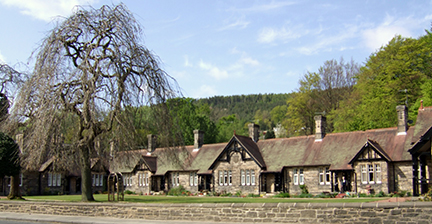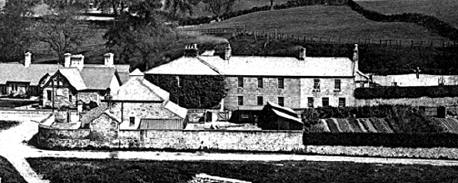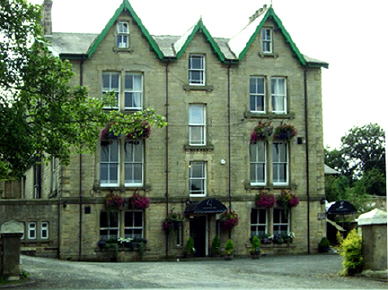Armstrong Cottages
In 1896
following the demolition of the original Alms House to make way for the
United Reform Church in the centre of the village Lord
 Armstrong
erected a block of twelve cottages at the east end of Rothbury, on the main
road and adjacent to the old work house.
Armstrong
erected a block of twelve cottages at the east end of Rothbury, on the main
road and adjacent to the old work house.
Now named the Armstrong Cottages they were originally known as Alms Houses and were established as homes for aged estate workers. There is an inscription on the wall which reads:
"Erected
by
William George Baron Armstrong of Cragside
in Memory of Ann Armstrong His Much Loved Mother 1896"
Up to about 1900 the old work house stood on the north side of the main road into town and just opposite Riverside.
However in
1901 the Rothbury Board of Guardians purchased a new site on Silverton Lane (to
the south of the town) and by the following year a new workhouse and school was erected. This new workhouse could
accommodate up to 50 inmates. and was much larger than the original with wash
house, laundry, kitchen, shed and mortuary. Master & Matron's
accommodation was central with men's day room with dormitories to the east and
women's to the west. A school was built in front of the
workhouse. By 1920 this workhouse was known officially
as "Rothbury Poor Law Institution".
year a new workhouse and school was erected. This new workhouse could
accommodate up to 50 inmates. and was much larger than the original with wash
house, laundry, kitchen, shed and mortuary. Master & Matron's
accommodation was central with men's day room with dormitories to the east and
women's to the west. A school was built in front of the
workhouse. By 1920 this workhouse was known officially
as "Rothbury Poor Law Institution".
During the war these buildings were used to house Italian POWs and following the war were used as a geriatric home for women and the school became residential before being converted into a private dwelling, now know as Silverton Lodge. The workhouse was also converted into houses in the 1990's.
Just opposite the Armstrong cottages stands a terrace of houses known as Walby Hill. Now converted to B&Bs and offices for the Forestry commission these were originally built to house some of those who worked in a professional capacity on the Cragside Estate.
Crossing the river at Scottish Ford at the stepping stones will take you to the old Auction Mart above which lay the Railway Station. No trace of the station exists today and it is now a thriving industrial estate. The auction mart was once the pride of the area and a great social day for farmers coming from remote farms. As far as livestock is concerned it is now defunct although there are still sales of antiques, furnishings and memorablia quarterley.
It is interesting to note that the stepping stones were part of the old wartime defences along the riverside. Waste not want not!
The old sheep pens at the side of the Coquet Vale Hotel (formerly the Station Hotel) were finally removed in 2001. Some twenty houses were built on this site: another link with the past demolished! Built in 1880 to service the railway, the Coquetvale was one of the first in the area to install the telephone. Its number was "Rothbury 5" which over the years gradually increased in length to 01669 620305.
Over the years it passed though many hands but since the demise of the railway it seems to have struggled. At one time it was even scheduled to follow the fate of other large buildings and be converted to flats
 But following
an acquisition it is now well on its way to attaining its
former glory with
spacious good quality bedrooms
and an excellent restaurant,
Italia Plus, that was awarded Best Hotel
Restaurant for 2008.
But following
an acquisition it is now well on its way to attaining its
former glory with
spacious good quality bedrooms
and an excellent restaurant,
Italia Plus, that was awarded Best Hotel
Restaurant for 2008.
There are a number of stories associated with the Hotel.
In 1935 a previous owner Mr Baker named it "The Silver Grill" possibly referring to the Silver Jubilee of George V.
But what happened to the fertility chair that stood in lounge beside a matching table. Carved out of ebony with dragons heads in an oriental fashion, its origin is unknown. A number of people claimed to have given birth after having sat on it. Not gentlemen I hope!
There was also an owner who won the pools then bought the hotel. It had to be completely refurbished before any visitors were allowed. Mrs Carrie McLean is credited with this story as she was a temporary cook there.
Pass the
old girls school (also known locally as the Masonic Lodge) towards
the Bridge and back to your starting point
on the Haugh.
In the late 1990's, it was realised the Masonic Hall required
a great deal of expenditure if it was to remain viable
and there were concerns about its structural
foundations. It was sold and converted into holiday cottages and the
Masons moved to Alnwick
To the south of
the car park lie the Half Acres: a range of small fields. Villagers who had served in the ranks of the Percy Tenantry Volunteers,
during the Napoleonic Wars, were granted half acre strips by the Duke of
Northumberland in 1819 as a reward for their service. These half acre strips can
still be seen although, with hedgerows being grubbed out over the years, some have turned into full acres.
Incidentally an Acre is taken to be 4,840 square yards, or about 50 yards by 100
yards and it should be noted that Irish
& Scottish acres have a different measure of 7,840 and 6,150.4 square yards
respectively.
Even older traces of community cultivation have been found on the opposite side
of the river, comprising long strips of narrow fields, allotted annually to the
villagers. These fields were allocated in such a way that each man's holdings
comprised several non contiguous strips, and each person was obliged to
cultivate his strip of land in accordance with the crop rotation observed by his
neighbours.
This method of cultivation was popular in England as it forced crop rotation,
and ensured that each farmer cultivated a selection of crops rather than
concentrate on the most profitable at any given time. Does this sound familiar?
The strips were originally divided by unploughed ridges or balks, but over the
years these were levelled and the strips
started to form the complete field as they became the freehold of the
villagers. Dippie Dixon tells us that the last remaining strip exchanged
hands for a pair of leather breeches.
If you
have enjoyed this walk around the village, tell your friends.
If not tell me
coord@rothbury.co.uk